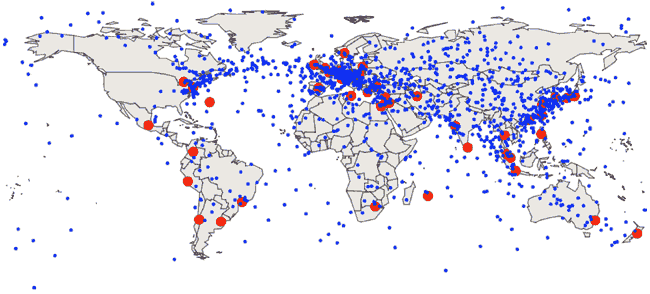The speed of light becomes a bottleneck for high-speed trading.
Physicists from the Massachusetts Institute of Technology want to help financiers to create the optimal structure of data centers for high-speed (high-frequency) trading. As you know, in this type of trading, the key advantage is the speed of data acquisition. For example, when hosting is placed on the same platform as the exchange servers, a delay of less than 500 microseconds can be achieved. For comparison, the speed of passage of a pulse (the speed of light) between the two most distant points on the globe is 67 milliseconds - 135 times slower! In reality, the application from New York is placed on the London Stock Exchange for 50 ms, that is unimaginably slow. This makes it impossible for high-frequency trading on overseas sites.
Since 52 world stock exchanges constitute a single world market that works round the clock, prices ultimately tend to the same level. The competitive advantage in the market is obtained by the trading office that receives data from overseas a few milliseconds faster than its competitors. Geographical proximity to the exchange becomes a valuable resource for high-frequency traders.
So, what did the MIT physicists come up with? They published ( PDF ) in the Physical Review journal a purely theoretical model of “relativistic statistical arbitration” (relativistic statistical arbitrage), in which they calculate the optimal location of coordination data centers for each pair in the set of 52 main exchanges. Scientists have proven that such a location is optimal.
Although many centers are located in areas with a dense fiber-optic coating, others are located in remote corners of the earth and even among the oceans.
')

Since 52 world stock exchanges constitute a single world market that works round the clock, prices ultimately tend to the same level. The competitive advantage in the market is obtained by the trading office that receives data from overseas a few milliseconds faster than its competitors. Geographical proximity to the exchange becomes a valuable resource for high-frequency traders.
So, what did the MIT physicists come up with? They published ( PDF ) in the Physical Review journal a purely theoretical model of “relativistic statistical arbitration” (relativistic statistical arbitrage), in which they calculate the optimal location of coordination data centers for each pair in the set of 52 main exchanges. Scientists have proven that such a location is optimal.
Although many centers are located in areas with a dense fiber-optic coating, others are located in remote corners of the earth and even among the oceans.
')

Source: https://habr.com/ru/post/110092/
All Articles